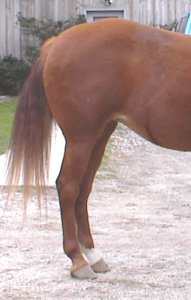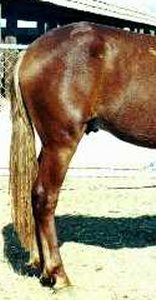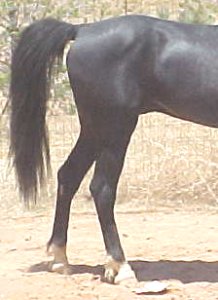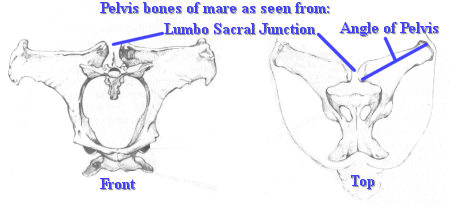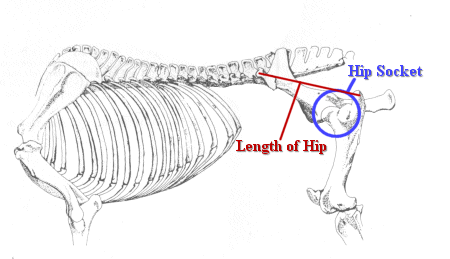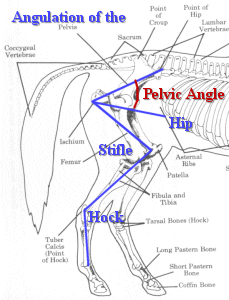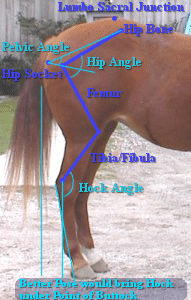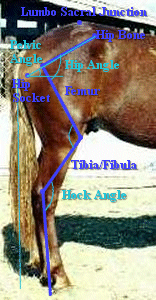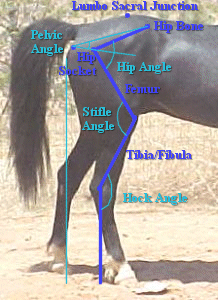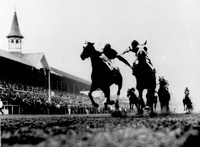While front end conformation determines more how a horse will perform a gait than which gait he will do well, rear end conformation gives a good clue as to which gait a horse will do as well as how he will do it.
The things to look at in rear end conformation are the placement of the lumbo sacral junction, the length of the hip, the angle of the pelvis, the placement of the hip socket on the pelvis, the relative lengths of the femur, tibia/fibula (bones from stifle to hock) and cannon, and the angulation of the hip, stifle and hock.
|
| These things will determine the ability or lack thereof of the horse to round his back (lower his hindquarters from the lumbo sacral junction). They will also determine the type of step he takes in back — long or, short, powerful and pushing or high and “hocky”.
In general, horses with lumbo sacral junctions located directly over the hip bone, long hips (more than 30 % of their bodies) and pelvises that do not have a steep slope or a flat one ( approximately 20 degrees), hip sockets placed toward the center of the pelvis, femurs and tibia/fibulas at about the same length, and are inclined to more diagonal gaits with a long, powerful pushing stride behind. Horses with lumbo sacral junctions placed to the rear of the hip bone, short hips ( less than 1/4 of their body length), steep pelvic angles (more than 45 degrees) or overly horizontal ones, hip sockets placed toward the rear of the pelvis, short femurs and long tibia/fibulas are less likely to be able to round their backs and step strongly under themselves, and so are inclined to more lateral gaits, often with a shorter, higher step in back.
Many of the traits of hind end conformation that are common in gaited horses can contribute to unsoundness if they are exaggerated or the horse is used for purposes that are not appropriate to his conformation. For example, a horse with a long stifle to hock measurement, whose hock lies behind the point of his buttocks when the hind cannon is vertical (said to be “camped out”) will take a long step in back with that hind leg and may have a good deal of overreach in his gait because of it. This sort of hind leg is appropriate for long overreaching steps in a straight line on flat ground — however, it is not appropriate for quick turns, sliding stops or other maneuvers that are best done with downward flex from the lumbo sacral junction and the hock bearing weight under the mass of the body of the horse. It is also not the best construction for climbing steep hills or coming down them — again because the hock does bear weight well under the mass of the body.
Rear End One |
This horse is posed in a slightly sickle hocked position, although I do not believe that the horse is actually sickle hocked. The hip is long and deep, the lumbo sacral junction is almost over the top of the hip bone, the pelvis has a moderate angle, the femur and tibia/fibula are approximately the same length, and the hip socket appears to be set moderately toward the rear of the pelvis.
With this conformation this horse should have good power for hill climbing, moderate reach under the body, no high hock action and the ability to cut a cow if necessary. This horse’s gait, all other things being equal (and there are a lot of things that are not visible in this picture that will have an effect on which gait the horse does) is most likely a fox trot or trail type running walk, if this is not a hard trotting horse.
|
Rear End Two |
Again, this horse is posed in a sickle hocked position and is indeed slightly sickle hocked. His hip is relatively short compared to “ideal” trotting horse conformation and it is also steep, much steeper than that of either of the other two horses pictured. His lumbo sacral junction lies well behind his hip bone.
His femur is somewhat shorter than his tibia/fibula. His hock angles are quite open, his stifle angle somewhat closed. All incline him to a lateral gait, with somewhat high “hocky” action in his hind legs, and little or no over stride. I would imagine that his gait is in the rack family, either corto/largo or stepped rack. He would also be quite capable of hill climbing, and some quick or tight turns.
|
|
Rear End Three |
This horse is posed with his hind legs somewhat angled, which makes it a little hard to see the exact placement of the hock in relation to the buttock.
However, he does appear to be a bit camped out, that is his hock lies behind a plumb line drawn from the point of his buttock. His hip is relatively short, his lumbo sacral junction lies behind his hip bones, his pelvis is not as steep as horse #2, and may be more horizontal than horse #1 (hard to tell with this pose). His femur is relatively short, his tibia/fibula is relatively long, and his hind cannon is quite long. His stifle is again somewhat closed in angle, and hock very open.
This, assuming again that the rest of his body also fits a “gaited” model, inclines him to a gait other than a trot, most likely a running walk, or perhaps a show type fox trot, and also inclines him to take long steps with his hind legs, over striding a considerable amount in the walk or his gait, but without high hock action. He is built to move well over flat surfaces, but is probably not best suited to quick turns or sliding stops, or really steep hill climbing.
| |
